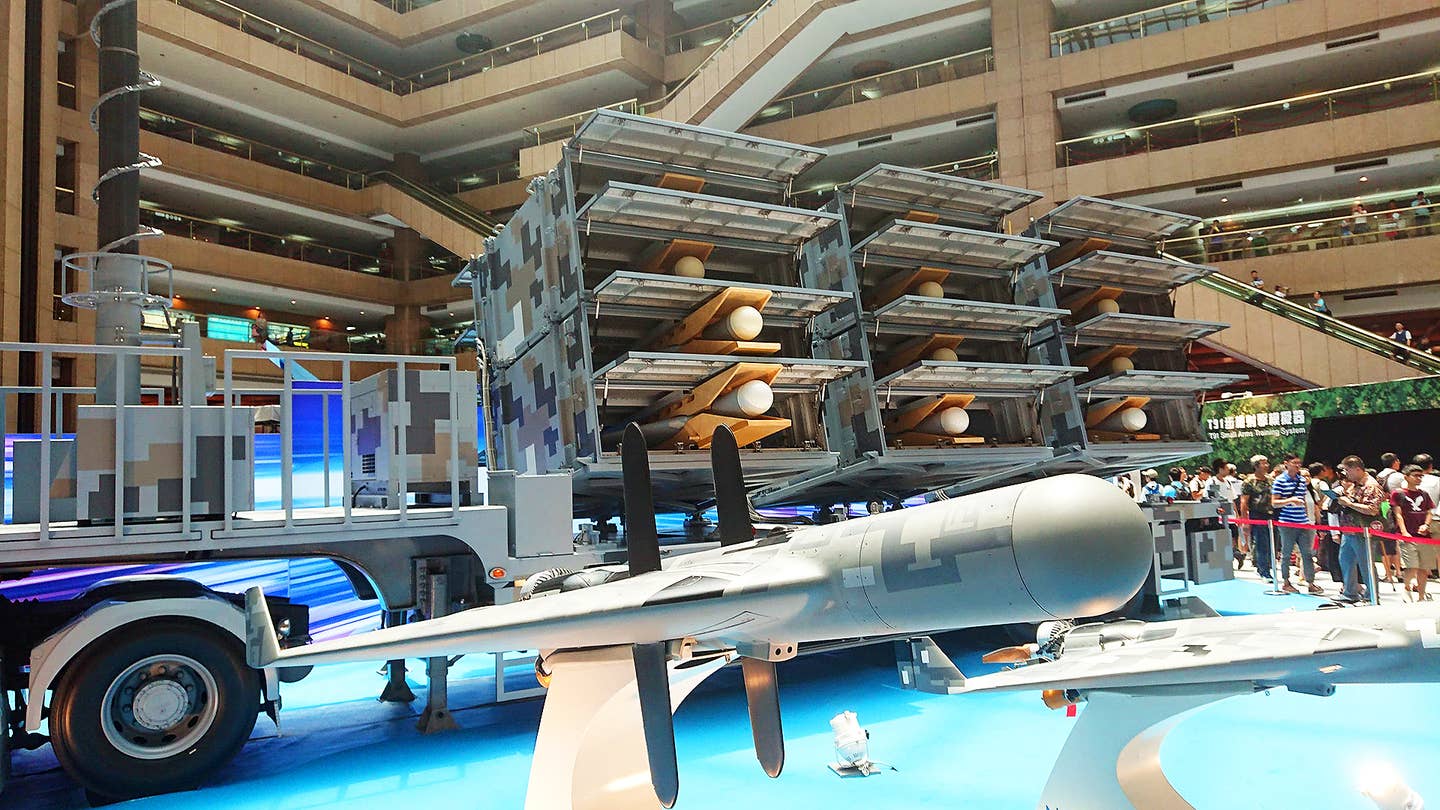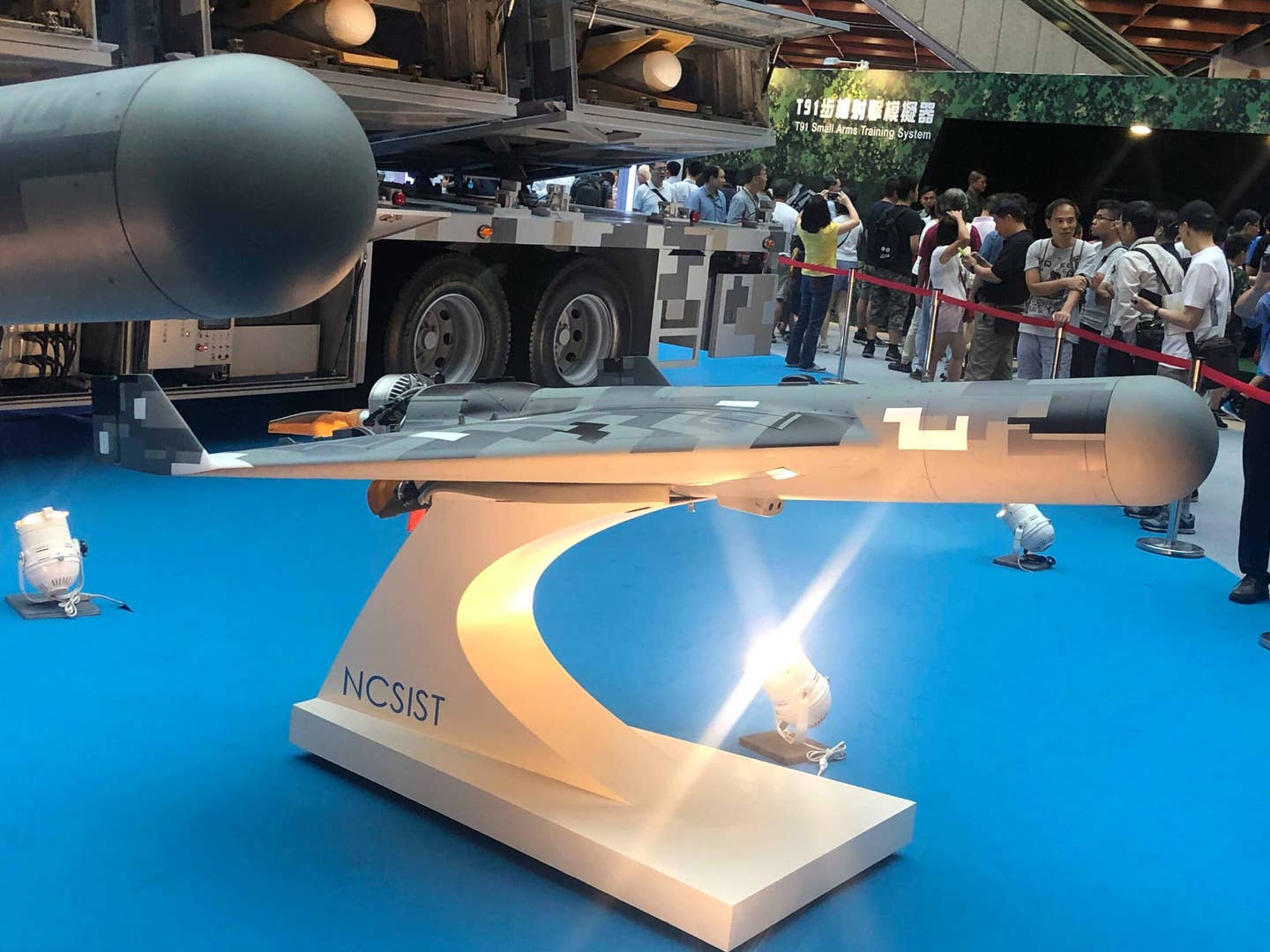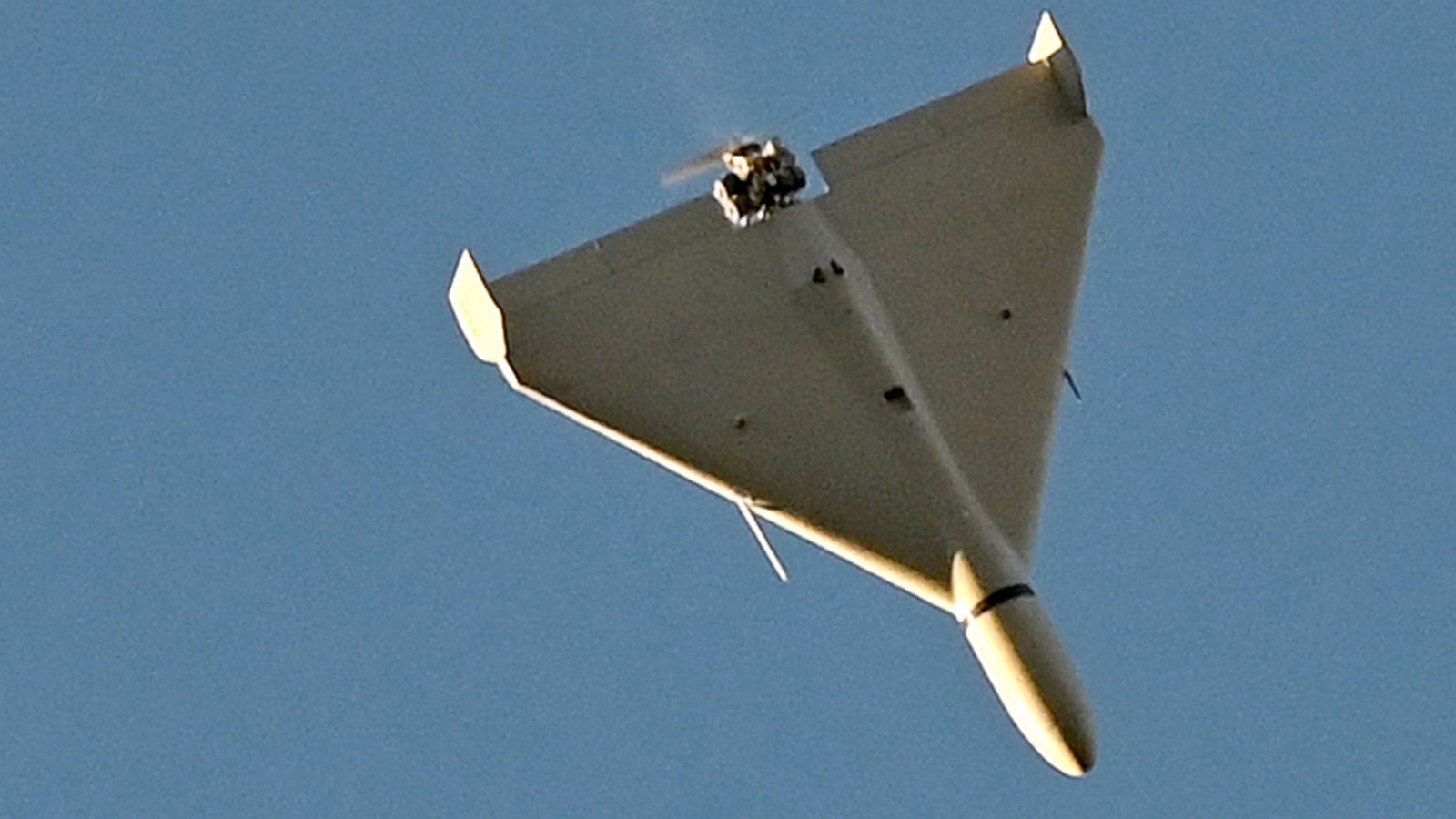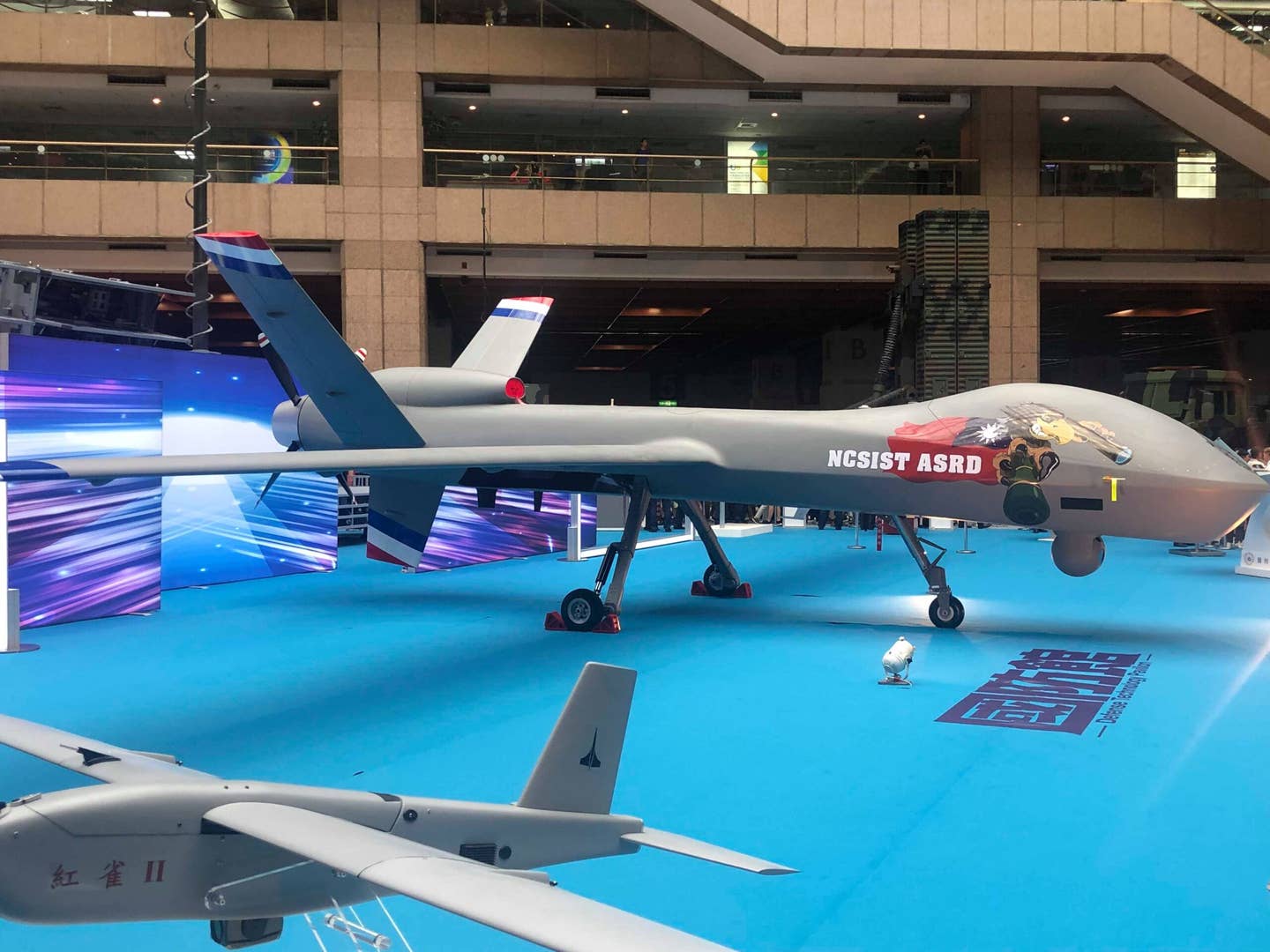EMMA HELFRICH

Taiwan this Tuesday invited the media to an exhibition of various capabilities from its locally developed drone arsenal. Two specific systems that were pointedly highlighted in coverage of the event were the vehicle-launched Chien Hsiang loitering munition and the Teng Yun reconnaissance drone that is known for bearing a resemblance to the MQ-9 Reaper. The exhibition showcased diverse uncrewed developments in Taiwan, which could be a factor in a future conflict with the mainland as threats to the island's sovereignty grow.
The drone exhibition event was hosted by the National Chung-Shan Institute of Science and Technology (NCSIST), a Taiwanese government-owned military technology manufacturer that develops a wealth of the Republic of China Armed Forces’ weapons like the Hsiung Feng anti-ship missile and the Yun Feng supersonic cruise missile.
NCSIST provided an especially rare look at one weapon in particular: the truck-launched Chien Hsiang. These indigenous anti-radiation loitering munitions are designed to take out enemy radars positioned at sea, on the coast, or inland, according to NCSIST. The company also claimed that Chien Hsiang can strike other unmanned aerial vehicles (UAVs), but it wasn't made clear exactly how this is achieved. It's possible it could home in on the emissions of slower-moving drones and attack them, but that would be a relatively limited and questionable use case.
The Taiwan government-owned news outlet Focus Taiwan covered a press briefing held at the event during which Chi Li-ping, head of the NCSIST’s Aeronautical Systems Research Division, revealed that Chien Hsiang has a maximum flight time of five hours and can strike targets approximately 621 miles away (1,000 km).
 The Chien Hsiang loitering munition on display at the 2019 Taipei Aerospace & Defense Technology Exhibition. Credit: Kenchen945/Wikimedia Commons
The Chien Hsiang loitering munition on display at the 2019 Taipei Aerospace & Defense Technology Exhibition. Credit: Kenchen945/Wikimedia CommonsThe exact control architecture for Chien Hsiang isn’t clear, but Focus Taiwan did quote Chi as insisting that if the drone were to lose its signal while en route to a target that it could instead loiter in the area for an undisclosed amount of time while waiting for the target to radiate again before locking on to the emitter and completing the strike. This is generally how these types of loitering munitions work — they fly on autopilot to a threat area and wait to detect a preprogrammed electronic 'fingerprint' of a radiating threat system and then attack it autonomously. Having a man-in-the-loop is not necessary. Attacks are then carried out by Chien Hsiang executing a downward swooping motion before crashing into the target at 372 mph (600 kmh), according to Chi. Chien Hsiang can also work as a decoy and can potentially be equipped with an electronic warfare package for stand-in jamming of enemy emitters. And, of course, there is no reason why these drones could not be used to strike non-emitting static targets.
While NCSIST has said that it's purely coincidental, Chien Hsiang is extremely similar in form and function to Israel’s IAI Harpy. Many years ago, Israel pioneered this loitering munition concept, which has recently proliferated around the globe. You can read all about this and Harpy in this past feature of ours.
This general design has been iterated now by other countries, most notably Israel's nemesis Iran. The Iranian Shahed-136 drones that are wreaking havoc on Ukraine are similar, and variants can be equipped with an anti-radiation seeker or used more as a missile to hit fixed targets over long ranges.
 A Shahed-136 diving onto its target in Ukraine.
A Shahed-136 diving onto its target in Ukraine.Chien Hsiang was first seen at the 2017 Taipei Aerospace & Defense Technology Exhibition without its official designation, and its vehicle-based launcher configuration was then unveiled at the same event in 2019 where it could be seen with 12 canisters each loaded with one of the loitering munitions. Chi claimed that all 12 Chien Hsiang drones can be launched at once in a ‘cluster’ without the need for a runway thanks to its mobile launcher.
This means the system can launch from all over Taiwan’s main island in a ‘shoot-and-scoot’ fashion, but also allows it to be transported to outlying island installations when needed. Fixed ground-based launchers or those carried aboard the Republic of China Navy’s surface combatants can also purportedly deploy the Chien Hsiang drones.
Chi said that the production and delivery of 104 Chien Hsiang munitions are projected to be completed by the 2025 deadline originally set by NCSIST, but they did not go into detail about exactly how many Taiwan has ordered, or plans to, in total. One would imagine the total order could be substantially bigger in the future.
Also progressing on schedule is NCSIST’s Teng Yun drone, which takes after the U.S.-designed MQ-9 Reaper in appearance. Chi said during the press briefing that Teng Yun could enter mass production once it passes a combat readiness evaluation next year. While Chi didn’t specifically note whether he was referring to the pioneering Teng Yun design or its improved variant Teng Yun 2, it is likely that the latter is the derivative slated to enter combat readiness testing as the drone just recorded a milestone 10-hour test flight this summer.
According to NCSIST, Teng Yun is designed primarily to perform in a reconnaissance role for the Republic of China Armed Forces. Focus Taiwan reported that the drone, which was first unveiled in 2015, is engineered with a synthetic aperture radar and can be controlled via satellite. NCSIST says that Teng Yun has a maximum flight time of 20 hours.
 The Teng Yun loitering munition on display at the 2019 Taipei Aerospace & Defense Technology Exhibition. Credit: Kenchen945/Wikimedia Commons
The Teng Yun loitering munition on display at the 2019 Taipei Aerospace & Defense Technology Exhibition. Credit: Kenchen945/Wikimedia CommonsNCSIST also introduced its rotary-wing uncrewed reconnaissance aircraft during a flight demonstration at the event, of which Chi said Taiwan has purchased a total of 50 for use in coastal areas. The helicopter drone, which South China Morning Post is saying has been tentatively named 'Capricorn', can reportedly plot its own flight route and land autonomously. Chi told Focus Taiwan that the drone has a maximum flight time of over an hour, a range of over 18 miles (30 km), and the ability to transmit images in real time for precise scouting. The article also noted that the Republic of China Army has already received 14 of these aircraft.
In order to fly the droves of drones that are being developed in Taiwan, the Republic of China Armed Forces have reportedly recruited 115 drone operators to make up for insufficient manpower in this area. Focus Taiwan divulged that these recruits were then trained by the NCSIST and tested on their knowledge with an exam administered by the Taiwanese Civil Aeronautics Administration.
How the newly qualified operators will be dispersed across the services is unclear, as are the unspecified types of drones they were qualified to operate. However, the development nonetheless shows that Taiwan is working to catch up in the unmanned space, which is an area of Taiwan’s overarching military strategy that experts have said is lacking.
While there doesn’t appear to be any direct correlation, it is worth noting that NCSIST’s Tuesday event took place two days after China’s 2022 Zhuhai Air Show wrapped. The week-long expo was intended to showcase all of the next-generation air combat technologies that are either in development or already in use with the People’s Liberation Army, and the event made it difficult not to see how competitive China is becoming in this regard.
Drones and loitering munitions could be particularly decisive in a future cross-strait conflict, which is something that even the United States has explored, especially in terms of drone swarms, during independent think tank simulations with the Air Force. The war in Ukraine has only underscored the value of drones, with both sides of the conflict having seen varying degrees of success in deploying both reconnaissance and attack drones of different types.
No comments:
Post a Comment